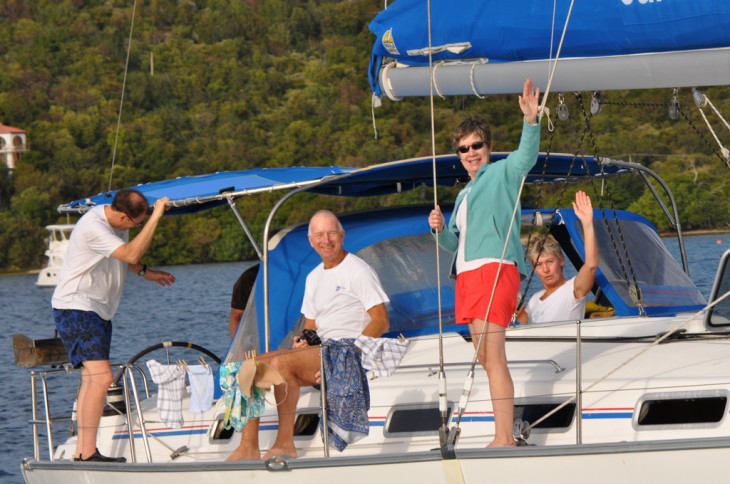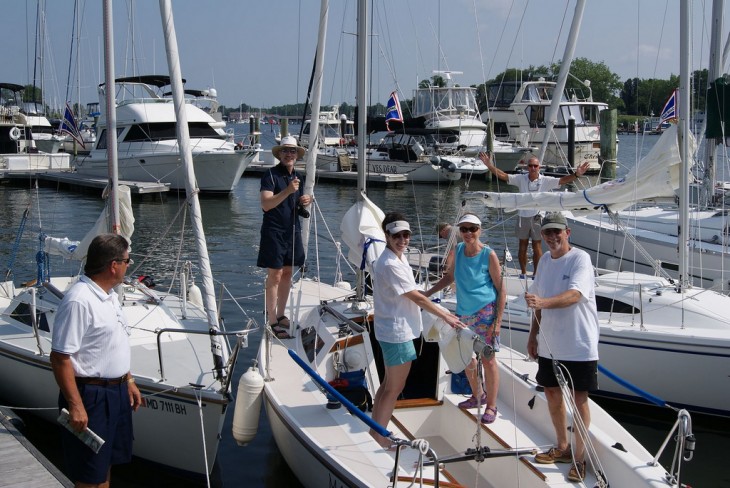
by Capt Lisa Batchelor Frailey
Is this article for real? Isn’t “Happiness” synonymous with “Bareboat Charter”? History tells us that crew morale is a topic that has occupied many a captain, and has inspired some notable solutions. Pirates have long advocated distribution of booty amongst the crew. The Royal Navy used a ration of grog. Jimmy Buffet suggested cheeseburgers and margaritas. One of the most rewarding aspects of being a charter operator and charter captain is working with people on vacation, when they are relaxed and happy. Cultivating and maintaining a happy bareboat charter crew is an important skill which requires preparation, a healthy dose of reality, careful attention and active leadership. It also requires a good sense of humor and enthusiasm! Read on for tips to keep your bareboat charter crew happy; send in your favorite tips!
The most crucial steps to cultivating a happy crew are done well in advance of your charter:
Compatible Crew Selection
Living together in a confined space – even for a week – can challenge the most flexible of personalities. When choosing your bareboat charter crew, pay attention to personal compatibility. Your crew need not be best friends to start with, but they should be accommodating, flexible, and enthusiastic about sailing and about being together onboard. Charters are great ways to bring adult families together, but recognize that familiar roles may be reversed in this new environment. Be realistic; if your family does not enjoy spending a 2-day holiday together, a week of togetherness afloat isn’t likely to improve the situation.
Choose the Right Boat for the Crew
Refer to “Book it Right” (July 2010 E-News) to ensure you’ve selected a boat with the right performance features and amenities to keep your crew happy, and within budget. A catamaran may be the perfect solution if members of the crew don’t like heeling, or require more privacy than a monohull affords. Space onboard matters, especially when weather might not cooperate with your plans. Consider if you need a head for every cabin, generator & air-conditioning, or a dodger/bimini combination. A late-model, well-maintained boat can be well worth the extra cost, and can save you and your crew aggravation. For larger crews (or crews with diverse interests), consider adding a second dinghy or a kayak. You’ll appreciate the extra flexibility it affords.
Set Realistic Expectations
When gathering your bareboat crew, don’t promise what you can’t deliver. While some charter boats have more amenities than others, remember that you are basically camping on the water. Be sure you and your crew have realistic expectations regarding the boat that fits your budget, features onboard, meals, predominant weather and destination activities. I well remember the charterer who returned shocked and angry, having discovered that Chesapeake Bay winds were hot and light in August. Be sure your crew understands that you won’t have a service staff onboard, and that all crewmembers need to pitch in to help with domestic duties. If your proposed crewmembers state that their idea of camping is the Hilton and room service, perhaps a bareboat charter isn’t the best idea. Bareboat means…just that! Set realistic expectations, and be ready to flex with the inevitable surprises.
Now, having procured the boat and selecting a compatible crew with realistic expectations, the next steps follow naturally!
Provision for Success
Whether your crew wants to dine ashore or afloat, be sure you accommodate food and beverage preferences in your provisioning plan. Bareboat charter companies offer many options, and prior planning is key. Keep in mind the galley facilities, ambient temperatures and food availability at your charter location. Will you want Beef Wellington in the tropics, or Caribbean chicken salad in Croatia? Why not immerse in local specialties? Most people are likely to eat and drink more on vacation than while at home, and happy hour can easily stretch to two hours… so count on extra quantities in your provisioning. Good food and beverages are important facets of a bareboat charter. Go as elegant or basic as your crew desires!
How to, When to…
Your crew now understands that everyone participates in onboard duties. Everyone will want to help, but new crewmembers may not know how or when. Make a list of duties that need to be taken care of, and let crewmembers choose – either for the entire charter, or for rotating chores. Keep it “fair and balanced” so everyone is involved and engaged in both domestic and seamanship/sailing activities. Demonstrate proven techniques, and be open to learning new ones!
Charter Etiquette
Domestic practices onboard may be very different from those at home, so coach your crew on charter etiquette (details in upcoming article). Focus on topics including use of the marine head, water conservation, refrigeration and cleanliness onboard – it will pay big dividends for the greater enjoyment of all crewmembers. Lead by example.
Itinerary Plan
Learn what your crew wants to see and do before your charter begins – must-see attractions, snorkel, hike, lie on the beach, explore. Design the itinerary to balance sailing and shore time. Consider spending an extra day at favorite destinations, so the crew can relax and explore. For more detail, see “Planning an Itinerary in December 2010 E-News.
Kids Onboard
Chartering with kids can be a fabulous vacation, especially if you include excursions ashore where they can swim, climb and explore. (Assuming that they like to swim, climb and explore!) Bring along favorite books and games, and have the kids keep a journal of their adventures. They’ll have memories to last a lifetime.
When in Rome
If you are in foreign waters, coach your crew to be good guests and ambassadors. Read ahead so you can understand and respect local traditions and cultures – your crew will have a more rewarding experience. Plan accordingly if shore facilities close down for afternoon riposa or siesta, or dinners ashore are offered much later than you’re used to. Many first-time Caribbean charterers are surprised by the early sunsets in the Caribbean winter. While it feels like summer, you may only have 10 hours of daylight to pack in your charter activities – or eliminate a few. Getting to your favorite snorkeling location with optimal light may mean an early rise and departure. Or, adapt to island time and spend an extra day!
Be Inclusive, but Respect Private Time
There’s a fine balance between crew togetherness and respecting privacy. Be inclusive – be sure everyone on the crew feels welcome to participate in activities onboard and ashore. But respect individual’s desires for privacy; sometimes people need some time alone, without the pressure for group activity. Along those lines, captains may need to set appropriate “quiet hours” so that crewmembers (and harbor neighbors) can sleep. Charter boat bulkheads are thin, hatches are open, and sound travels easily!
Pay Attention
Watch your crewmembers – body language can tell you as much as verbal communication. People express anxieties in many ways – some get edgy or giddy, some get drunk, and others withdraw. Have a private conversation, and find out the issue – it may be a simple need for more privacy or a phone call home, or a bigger issue of illness, anxiety or a personal conflict onboard. Address the issue before it gets out of hand. Don’t try to be a psychologist – just a captain.
Gripe Session
If you have a morning pre-departure brief, allow for a short gripe session where crewmembers can air issues in a constructive manner. If public airing is not appropriate, invite crewmembers to speak with you privately. A small problem, rapidly aired and corrected, can prevent greater problems and resentment.
Praise in Public
A leadership axiom in any environment, this is equally important on a bareboat charter. It’s easy and natural to praise the cook for a fantastic meal. But every crewmember is pitching in, often at unfamiliar, menial or “thankless” tasks. Having all contributions acknowledged can go a long way to bolstering crew morale.
Music, Maestro!
Your crew will have varied tastes in music, and you’ll likely come upon some new local music during your charter. Invite your crew to bring along their favorites, and rotate the selection so everyone can enjoy the music. There’s something about rum and reggae that gets people dancing on deck!
Theme Party
A locally-flavored theme party near the end of your charter can really add to the happiness quotient, and provide great photos too! No need to pack extra gear; crewmembers dress in locally-procured garb, and feast on local favorites or provisioning leftovers! Invite your harbor neighbors to join the fun.
Cultivating and maintaining a happy bareboat charter crew depends a great deal on the personalities of the individual crewmembers – so choose your crew and boat wisely, and set realistic expectations. After that, train and coach on location or charter-specific topics. Pay attention to verbal and non-verbal signals so you can nip issues in the bud. Above all, encourage participation, praise liberally, and set the example with humor!
Copyright © 2010, Lisa Batchelor Frailey
All rights reserved.
Link to original article: http://www.asa.com/enewsletter/mar2011/happy_crew.html


 Marine Weather Sailing Course
Marine Weather Sailing Course Coastal Navigation Sailing Course
Coastal Navigation Sailing Course







